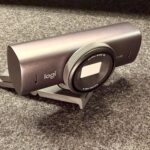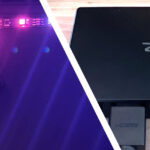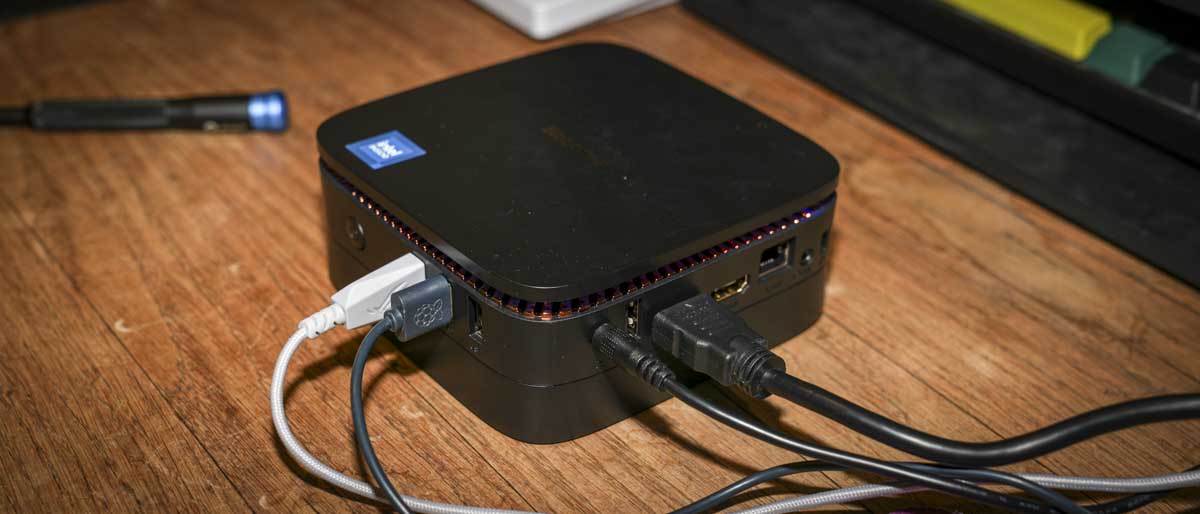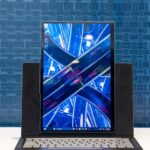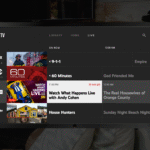Why you can trust TechRadar
We spend hours testing every product or service we review, so you can be sure you’re buying the best. Find out more about how we test.
Blackview MP60: 30-second review
The Blackview MP60 mini PC is there to fulfil a need, essentially, a budget, entry-level mini PC that can be used for work purposes without costing a fortune. When I checked through the features of the MP60, it was instantly apparent that it’s been designed solely for lightweight use, and shouldn’t be considered for anything more than browsing the internet, editing documents and media playback.
First and foremost, I could tell from the moment I took it from the box that the MP60 is designed as a cheap and affordable Mini PC. The design and build are plasticky and lightweight. However, that said, it still has a decent enough quality overall. In fact, it’s been designed in such a way that makes accessing the internals relatively easy and there’s a nice touch in as far as a standard 2.5-inch SATA SSD can quickly be installed.
The machine also comes with a good amount of mounting options, so there’s the usual VESA mount and two sockets where it could be hung like a picture if needed. When it comes to ports and base features, everything you need is there. So, as long as you’re just looking to browse the internet, use productivity applications such as Google Drive or Microsoft Office, and watch multimedia and streaming services, then this machine should provide everything that you need, but again with no frills.
As I started to drill down into the specifications, I could see that almost everything about this machine been pared back by Blackview to make it as affordable as possible. So, whereas with most new releases, you’d have the latest USB or, at the very least, USB 3.2 Gen 2, the fastest interface on offer here is USB 3.0, considerably slower than what you’d usually expect.
However, there are some really good positives, such as decent connectivity technologies like Wi-Fi 6 and Bluetooth 5.2. The Blackview MP60 also comes pre-installed with Windows 11 Pro, which, as a standalone retail version, would cost almost the same as this entire machine.
In real-world testing, Microsoft Office and all Google Docs worked absolutely fine, especially anything in a browser-based environment. Working on documents and Excel sheets caused no issues with speed, but even then, I could feel I was starting to push the limits of the system. When opening up PowerPoint and using graphic-intensive slides, there was a noticeable slowdown.
Likewise, doing anything more advanced like editing video, I could adjust and manipulate footage in CapCut, but taking it up to Adobe Premiere or DaVinci Resolve is really beyond this system’s abilities. Adobe Photoshop and Lightroom online (within a browser) will work fine, but the desktop-based options that are more processor- and graphics-intensive again show the system struggling.
Switching over to games, older titles were just about manageable, but it still struggled. When it comes to playing Hogwarts Legacy or Indiana Jones and the Great Circle, these games were just off-limits.
This is in no way one of the best mini PCs I’ve tested. If you’re looking for a machine for office-based work, then, while a little bit on the slow side, this machine will suffice. But really, for anything more, you’re going to need to look elsewhere.
Blackview MP60: Price & availability
- How much does it cost? £180 / $180
- When is it out? Now
- Where can you get it? Widely available
There are several versions of the Blackview MP60 mini PC on the market, and the one reviewed here is the Intel N150-based option, which retails for about £180 / $180 and can be configured through the Blackview website. The machine is also available via many online retailers such as Amazon.
Blackview MP60: Design
Specifications
CPU: Intel Processor N150
Graphics: 4K Intel UHD Graphics
RAM: 16GB DDR4 SDRAM
Storage: 512GB M.2 SATA (Max 2TB)
Front Ports: 2 x USB 3.2, USB 2.0, power
Rear Ports: DC, USB 2.0, 2 x HDMI, LAN 1000Mbps, 3.5mm audio
Connectivity: 5G Wi-Fi, BT 5.2
Audio: 3.5mm
Camera: N/A
Size: 128 x 128 x 52mm
Weight: 390g
OS installed: Windows 11 Pro
Accessories: N/A
At 390g, this mini PC is surprisingly lightweight. Measuring 128 x 128 x 52mm, and while it’s not particularly large, it is slightly bigger than some other mini PCs I’ve recently reviewed. Taking the mini PC from the box, the first thing I noticed was how lightweight it is. While the plastic finish is decent, you can definitely tell it’s entry-level. The moulding is good on the top and sides, but flip it over, and it just looks cheaper than what you’d usually expect.
Looking around the machine, everything is kept simple. There’s a slightly odd layout with the power button, USB 3.0, and a USB 2.0 port on the front. Then on the right-hand side, there’s a single USB 2.0 Type-A, 2 HDMI ports, a network port, and a 3.5mm audio jack. It keeps things to the bare minimum, which is fine for office-based work, but if you’re looking for more, this might feel restrictive.
Opening up the machine was interesting. On the base is a flap that looks like a battery flap on a toy. Undo two screws and lift it away to reveal a SATA connector, showing that a standard 2.5mm SSD drive can be plugged straight in, instantly giving you the ability to expand internal storage with a single connector. There are two quick releases on either side, pull them down, and the base of the machine lifts away.
What’s surprising is the connector between the SATA drive and the rest of the machine is USB-C. So it’s odd that they didn’t use USB-C for the main external ports.
Under the four rubber feet are four more screws, undoing these gives full access to the internals. Unlike other machines where you can replace the RAM, the RAM here appears to be integrated into the motherboard. The only upgradeable component is the SATA SSD, which is easily accessible through the base. Given there’s already a 2.5mm SATA drive, I can’t really see any reason to upgrade. On the motherboard there’s also a spare SATA connector, but there’s no scope in the design to actually connect a seconardy drive.
Looking at the design and build of the case itself, it’s interesting. The N150 CPU is a solid budget choice, sufficient for basic use and decent for a home media centre. It’s not a top-tier CPU, but it still generates a bit of heat, Blackview has worked hard to ensure the cooling system is effective, and sure enough over a week of use, the machine ran quietly, even while streaming media and I was impressed with just how quiet-running the machine was.
Blackview MP60: Features
The features of the MP60 is a bit like taking a step back in time. First of all, you have an Intel N150 3.6GHz 13th Gen TwinLake processor paired with 16GB of DDR4 RAM and a 512GB M.2 SATA drive. It does, however, come pre-installed with Windows 11 Pro, which is handy if you’re working in a corporate environment where remote monitoring and updates are required.
In terms of size and weight, it’s extremely portable. If you want a machine as a multimedia centre for the office or to use at events, then this could be a suitable option being easy to mount or store out of view.
While the CPU and GPU performance isn’t outstanding, it can still support dual 4K UHD displays. So, if you’re working on spreadsheets and need to have a spreadsheet and a Word document open at the same time, that’s perfectly feasible.
Around the machine, there are plenty of ports, but, as mentioned earlier, they’re all slightly outdated. While they offer decent backward compatibility, they won’t deliver cutting-edge data transfer speeds. Again, for office tasks, that’s fine, but for multimedia or advanced work, you’ll want to look elsewhere.
Wi-Fi 6 is supported, operating at both 2.5GHz and 5GHz, and Bluetooth 4.2 also fetaures, so compatibility with most keyboards, mice and other devices is covered. As features go there’s nothing here that really stands out with the one highlight being the fact that you can install a 2.5-inch SATA in the base.
Blackview MP60: Performance
|
Mini PC |
Header Cell – Column 1 | Header Cell – Column 2 |
|---|---|---|
|
3DMark |
WildLife |
3117 |
| Row 1 – Cell 0 |
Fire Strike Overall |
1203 |
| Row 2 – Cell 0 |
Fire Strike Graphics |
1310 |
| Row 3 – Cell 0 |
Fire Strike Physics |
5022 |
| Row 4 – Cell 0 |
Fire Strike Combined |
438 |
| Row 5 – Cell 0 |
Time Spy Overall |
437 |
| Row 6 – Cell 0 |
Time Spy Graphics |
388 |
| Row 7 – Cell 0 |
Time Spy CPU |
1580 |
|
CineBench23 |
Single |
599 |
| Row 9 – Cell 0 |
Multi |
1290 |
|
GeekBench |
Single |
1092 |
| Row 11 – Cell 0 |
Multi |
2148 |
| Row 12 – Cell 0 |
Compute |
4201 |
|
CrystalDisk |
Read MB/s |
542.60MB/s |
| Row 14 – Cell 0 |
Write MB/s |
505.10MB/s |
|
PCMark 10 |
Office |
2913 |
|
WEI |
Row 16 – Cell 1 |
6.7 |
Getting started with the Blackview MP60 involves finishing the Windows 11 Pro setup, choosing your options, clicking OK, setting a PIN, and you’re in.
I downloaded the software needed for benchmarking, including Steam, 3DMark, and PCMark, along with DaVinci Resolve, Photoshop, Premiere Pro, and Lightroom. I also used Microsoft Office to test the main productivity apps.
Once everything had been downloaded and updates were installed (which took a few hours), I started running the benchmarks. Instantly I found Microsoft Office was relatively slow to load, but once open, writing and updating spreadsheets was normal enough.
I also worked on a PowerPoint presentation using Photoshop alongside. But running both at once began to push the system too far, performance slowed to an uncomfortable level, and I ended up switching back to another machine. It is possible to use both, but the slowdown is noticeable.
Photoshop alone worked fine for small edits, resizing, cropping, adjusting tone and colour. However, as soon as I began applying multiple adjustment layers and effects, the system lagged. Saving after every change became essential.
Lightroom was slightly less demanding and ran relatively well. There was still some delay when making adjustments, but it remained usable. For both Photoshop and Lightroom, switching to the web versions in Microsoft Edge proved more responsive, albeit still not perfect.
For video editing, opening CapCut and editing HD video was possible as long as the edits weren’t too involved. Adding templates quickly strained the machine. Opening Premiere Pro and DaVinci Resolve proved too much, both were unstable and laggy.
Gaming was also limited. Indiana Jones and the Great Circle and Hogwarts Legacy were unplayable. Older Steam games fared better but still pushed the system.
Really when it comes to the use of this machine the performance highlighted that the MP60 is suited to light office work. As long as you don’t push it with long PowerPoint presentations or complex Excel documents, it’s fine. Stick to Word documents, web browsing, and browser-based apps. The PCMark score of 2913 and Windows Experience score of 6.7 really confirm that this is an entry-level machine.
Editing in Adobe apps is limited. Lightweight photo editors are better suited. The lag in more demanding software is frustrating, and GPU benchmarks were generally too low to recommend these uses.
Premiere Pro and DaVinci Resolve are beyond their capabilities. CapCut works, until you apply templates. For gaming, it’s simply not suitable.
This is an entry-level Windows 11 Pro machine. Across most basic functions, performance is below that of many models that are not much more expensive.
Blackview MP60: Final verdict
At almost every point of this review, the machine struggles with one test or another. In Microsoft Office, it handles Word, Excel and PowerPoint, but larger files begin to slow it down. Most other applications also encounter issues, and it really only excels in internet browsing and media playback.
So, where does this machine fit in the market? It does have a place. With SATA expansion on the base, it’s an ideal option for media playback in an office. It’s cheap, has Wi-Fi when needed, and is great for displays. If you need a machine to play back video at an event or want a home media centre for streaming, this could be ideal.
Should I buy a Blackview MP60?
|
Value |
Good value, but base-level CPU and performance |
3 |
|
Design |
Relatively cheap build, but fulfils its purpose |
4 |
|
Features |
Feels dated but stable and functional |
3 |
|
Performance |
Runs Windows and basic apps fine; struggles beyond that |
2.5 |
|
Overalls |
Great price, but limited return |
2.5 |
Buy it if…
Don’t buy it if…
For more hardware focused on productivity, we’ve tested and reviewed all the best business laptops and best business computers.
Read the full article here



